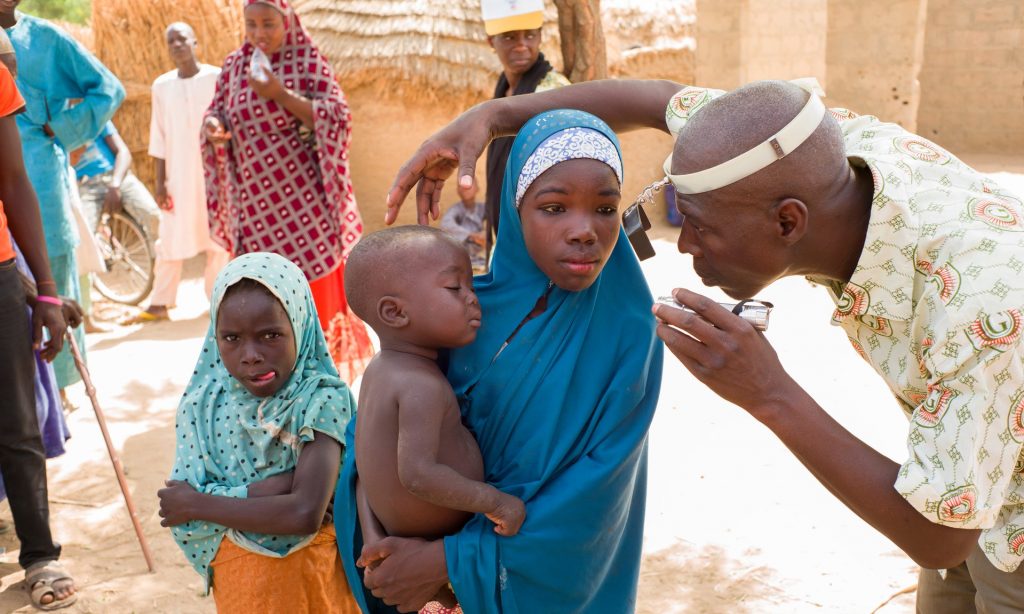
Photograph: Graeme Robertson for the Guardian
The number of children suffering from preventable blindness is increasing, partly because more children are surviving complicated births in low- and middle-income countries, specialists say. Worldwide, about 19 million children under the age of 15 are blind, with 12 million of these cases preventable or treatable.
Experts say one cause of high rates of blindness is retinopathy of prematurity (Rop), which occurs in premature infants and can be caused by being given too much oxygen after birth.
Brian Doolan, CEO of the Fred Hollows Foundation, said global advances in neonatal care mean more children are surviving early births, but this means more premature babies are at risk of Rop.
“They’re surviving because there’s improved medical care but often the quality of the care, particularly in relation to the manipulation of oxygen supplies, is not at a high enough level,” he said.
Doolan said other significant causes of childhood blindness include cataracts and glaucoma. “Aside from Rop, the increase [in rates of blindness] is also down to more children being born with cataracts and other problems, often as a cause or side-effect of malnutrition and diseases of poverty.”
Approximately three-quarters of the world’s blind children live in the poorest regions of Africa and Asia, where specialist eye health practitioners are scarce. Research by the International Agency for the Prevention of Blindness found there was a “critical shortage” (pdf) of optometry professionals in sub-Saharan Africa.
While advocating more specialist training to prevent and screen for Rop, Doolan said it is equally important to train teachers and primary health workers to recognise other eye problems.
“It’s not just about training optometrists or ophthalmologists, it’s about training primary health workers – and we’re talking about community workers, village health workers and teachers, who should be a part of any primary health workforce,” he said.
The Fred Hollows Foundation partnered Sightsavers to train 12,500 teachers in Cambodia to diagnose basic sight problems and refer children to specialists if required. The programme will now be rolled out globally after being adopted by the Global Partnership for Education and the World Bank.
“The important thing is helping governments realise how important this is. Children can’t benefit from the education you’re trying to supply if their eyes aren’t working properly,” Doolan said. “There is an economic incentive, too – for every $1 spent on restoring blindness in the developing world, the return is at least $4 back into the economy. This is about the equivalent to the return on investment for supplying clean water, or giving a child access to education.”
Lene Øverland, CEO of Orbis, an African eye health NGO, said a critical part of eye health is access to services, and there are often many barriers to this. “To eliminate avoidable blindness on the continent, eye health needs to be supported by partnerships outside of eye health and outside of the formal healthcare system,” Øverland said.
Traditional healers, who are often called on to treat blindness, can also play a role, particularly in rural areas where formal health services are lacking.
In South Africa’s KwaZulu-Natal province, an Orbis survey of healers found many were interested in learning more about how to diagnose eye problems, and how they might partner health clinics. Similar partnerships with traditional healers have taken place on HIV and Aids interventions in the region.
“The community surveys revealed a significant dearth of information about eye care not only among traditional healers, but also within the primary healthcare system and the general community at large,” the Orbis report said. “Collaborating with traditional healers could significantly reduce unnecessary sight loss within the rural communities in KwaZulu-Natal and strengthen the eye health referral system.”
Some parents who attended clinics with their children hid the fact they had also consulted traditional healers. One nurse said in the report: “It’s a family thing. Cataracts run in the family so people think they need to slaughter a goat. Medication from traditional healers is used. Herbs are crushed with a little water. Biomedicine is the last resort for people struggling with illness.”
The University of Cape Town’s Susan Levine, who conducted research for Orbis in Zambia, said: “Eye disease has taken a back seat to many infectious diseases in southern Africa, falling down the list of health priorities. But what bore out in our research is the extent to which diminished eyesight or blindness impacted people just as much, if not more, than some infectious diseases.”
She said she hoped the sustainable development goals, which include a target for universal health coverage by 2030, would shine a light on the deficits in eye health services. “From the perspective of the patients we spoke to, there is nothing more important than sight – it’s integral to education and their livelihoods. The emphasis on eye care and awareness of eye health is important to so many other facets of health.”

